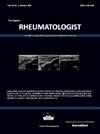Disease- and mental health-related predictors of quality of life among radiographic axial spondyloarthritis patients
IF 1
Q4 RHEUMATOLOGY
引用次数: 0
Abstract
Background
Radiographic axial spondyloarthritis (r-axSpA) significantly impacts health-related quality of life (HRQoL).
Aim of the work
To evaluate the disease-and mental health-related predictors of HRQoL in r-axSpA patients.
Patients and methods
Fifty-five r-axSpA patients and 55 age-, sex- and education-matched healthy controls were studied. Patients were evaluated by the Bath Ankylosing Spondylitis Disease Activity Index (BASDAI), Bath Ankylosing Spondylitis Functional Index (BASFI), Bath Ankylosing Spondylitis Metrology Index (BASMI) and patient global (PG) assessment of disease activity. Patients and controls were evaluated by the Short Form-36 (SF-36), its physical and mental component summaries (PCS and MCS, respectively), the Depression, Anxiety and Stress scale (DASS) and the Montreal Cognitive Assessment (MoCA)-Basic test.
Results
Patients’ mean age was 36.4 ± 7.48 years, median disease duration 10 years with interquartile range (IQR) (6–14) and 47 (85.5 %) were males. DASS scores were significantly higher while MoCA, PCS and MCS scores were lower in patients than controls, p < 0.001. BASDAI (r = −0.701), BASFI (r = −0.73), BASMI (r = −0.52), PG (r = −0.51), depression (r = −0.73), anxiety (r = −0.627) and stress (r = −0.691) scores showed significant negative correlations with PCS, p < 0.001. BASDAI (r = −0.602), BASFI (r = −0.668), BASMI (r = −0.37), PG (r = −0.45), depression (r = −0.74), anxiety (r = −0.63) and stress (r = −0.68) showed significant negative correlations with MCS; p < 0.001. MoCA significantly correlated with PCS (r = 0.36, p = 0.007) and MCS (r = 0.36, p = 0.008). On multivariable logistic regression analyses, PG and stress were independent predictors for PCS (β = −0.22, p = 0.041 and β = −0.35, p = 0.038, respectively), and stress was an independent predictor for MCS (β = −0.39, p = 0.035).
Conclusion
The PG assessment and stress scale are predictors of HRQoL in r-axSpA patients.
影像学中轴性脊柱炎患者生活质量的疾病和精神健康相关预测因素
x线摄影中轴性脊柱炎(r-axSpA)显著影响健康相关生活质量(HRQoL)。研究目的:评价r-axSpA患者HRQoL的疾病及心理相关预测因素。患者和方法研究了55名r-axSpA患者和55名年龄、性别和教育程度相匹配的健康对照者。采用巴斯强直性脊柱炎疾病活动指数(BASDAI)、巴斯强直性脊柱炎功能指数(BASFI)、巴斯强直性脊柱炎计量指数(BASMI)和患者整体疾病活动评估(PG)对患者进行评估。采用短表36 (SF-36)、其生理和心理成分摘要(PCS和MCS)、抑郁、焦虑和压力量表(DASS)和蒙特利尔认知评估(MoCA)-基本测试对患者和对照组进行评估。结果患者平均年龄36.4±7.48岁,中位病程10年,四分位间距(IQR)为6 ~ 14,男性47例(85.5%)。DASS评分显著高于对照组,MoCA、PCS、MCS评分显著低于对照组,p < 0.001。BASDAI (r = - 0.701)、BASFI (r = - 0.73)、BASMI (r = - 0.52)、PG (r = - 0.51)、抑郁(r = - 0.73)、焦虑(r = - 0.627)、压力(r = - 0.691)得分与PCS呈显著负相关,p < 0.001。BASDAI (r =−0.602)、BASFI (r =−0.668)、BASMI (r =−0.37)、PG (r =−0.45)、抑郁(r =−0.74)、焦虑(r =−0.63)、应激(r =−0.68)与MCS呈显著负相关;p < 0.001。MoCA与PCS (r = 0.36, p = 0.007)、MCS (r = 0.36, p = 0.008)显著相关。在多变量logistic回归分析中,PG和应激是PCS的独立预测因子(β = - 0.22, p = 0.041和β = - 0.35, p = 0.038),应激是MCS的独立预测因子(β = - 0.39, p = 0.035)。结论PG评分和应激量表是r-axSpA患者HRQoL的预测指标。
本文章由计算机程序翻译,如有差异,请以英文原文为准。
求助全文
约1分钟内获得全文
求助全文

 求助内容:
求助内容: 应助结果提醒方式:
应助结果提醒方式:


